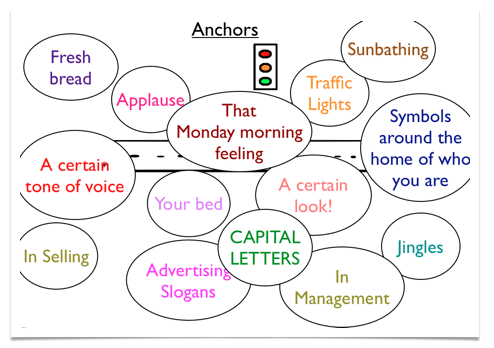NLP Anchoring
Anchor
An anchor is a stimulus that creates a response in either you or in another person. When an individual is at a peak of an experience, during an intense. emotional state, and if a specific stimulus is applied, a neurological link is established between the emotional state and the stimulus.
We develop good and bad anchors automatically throughout our lives and NLP training will enable you to identify and keep our good anchors and also identify and weed out our unwanted anchors, replacing them with more desirable ones.
Eg. When we used to have comfort breaks in the middle of films at the cinema, they used to flash up images of ice-cream on the screen and people looking the ice-cream with wide eyes, clearly salivating. Funnily enough the audience then found themselves salivating at the thought of ice-cream. Cue the ice-cream lady who would appear in the aisle laden with ice-cream goodies for sale!
We all do little things that others find irritating. Think of one of those things that someone else does that makes you feel irritated. The irritation is probably so well anchored, that you do not even need to see them do it to start feeling irritated, just the thought that they might do it should be enough to get you going!
Some anchors span each of our representational systems. This means that when they are applied we get a picture, sound, feeling, smell and taste. These are the most powerful of anchors.
Examples are:
- Art
- Smelling freshly cut grass
- Car Horn
- Picture of a holiday
If you would like to learn more about NLP anchoring, including learning the various anchoring techniques described below, then you can join us at one of our NLP Training Courses or Train in NLP online at our NLP Online Training Centre.
Anchoring using NLP
Anchors are visual, auditory or kinesthetic triggers that become associated with a particular response or state.
Anchoring is the process whereby an internal or external stimulus becomes a trigger that elicits a response. Anchors stimulate an action and when we see, hear, feel, taste or smell something frequently, we often respond in the same way and our states changes in response to it. As an example, an auditory anchor would be the sound of someone’s voice or visually it could be a messy room.
Certain experiences can create anchors, which is how negative emotions, fear or phobias can begin. We have a choice to stay in that state or use NLP techniques such as collapsing anchors to change how we feel. Collapsing anchors is when you fire two different anchors simultaneously (the old negative anchor and the new positive anchor) in order to change a state.
Steps in NLP anchoring
- Recall a past vivid event, experience.
- Anchor – provide a specific stimulus.
- Change state.
- Test (Place the stimulus) – Evolve the state.
Eg Anchoring the feeling of confidence.
- Recall a time when you felt really confident. When you think of that time do you have a picture? Get that picture.
- When you notice the picture place a finger from one hand on the knuckle of the other hand (remember which knuckle you selected!). Release the finger after a maximum of 20 seconds or earlier if you get the sense of the picture or feeling leaving you.
- Change your state by looking out of the window or smelling the air in the room that you are in.
- Replace your finger on the knuckle and notice for that feeling of confidence returning.
Keys to effective anchoring
- Intensity of experience. Make sure that the intensity of the experience is high.
- Timing of the anchor. Apply the anchor when the intensity of the experience is at its highest.
- Uniqueness of the stimulus. Use a part of the body that is not normally touched eg Knuckle.
- Replication of the stimulus. Reapply the stimulus repeatedly to ensure that the anchor is firmly embedded into the neurology.
- Number of times. Test the anchor repeatedly to exercise the neural pathway.
You can generate visual, auditory, kinesthetic, olfactory, and gustatory anchors. The least preferred representational system of a person is the one that it is most powerful to use with them as it is the one that you are most sensitive to.
NLP Resource Anchor
An anchor for when you want to boost energy, confidence, motivation, or any other powerful state of being. One that you do for yourself.
NLP Stacked Anchor
A number of anchors stacked together to increase intensity of the required state.
NLP Chaining Anchors
Sequential process of moving to a significantly different state.
Useful for when a client has a significant difference between their present state and the desired state. Each state builds on the one before until the desired state is reached.
NLP Collapse Anchor
Replacing a negative anchor with a positive one for the same stimulus.
NLP Search Anchor
An anchor used to identify the source of a problem or issue.
More NLP Anchoring in our blog

